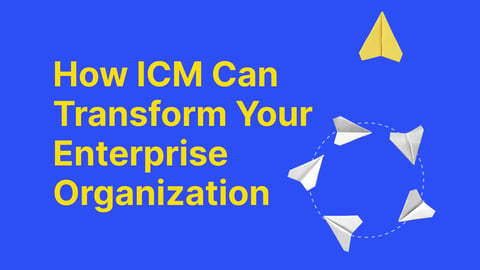The Challenges of Sales Management
Here the challenge is more strategic. You must ensure you have enough quality sales leads, the right people in the right roles, and enough deals to hit your quota consistently. Getting this right requires understanding the sales and forecasting process and how to get the best out of your sales team, business, and customer base.
Add to this the growing business demands – for more customers, deals, and revenue – and one can sympathize with the sales VP trying their best to stay ahead. One way to resolve this complex management challenge is to automate manual processes, including pipeline management, forecasting, and sales reporting. This is the classic use case for a CRM platform.
But recent technological developments, including cloud computing and AI analytical capabilities, mean other areas in the sales management process can be automated now too. Automating the sales compensation management process is top of mind for many sales leaders, as it takes a significant amount of their workload off their shoulders and helps them manage their sales team more effectively.
Before we go into the detail of automating your sales compensation management and the significant value it brings, let’s highlight some of the key issues surrounding compensation management to help build the business case for automation.
The Value of Compensation Management
A business's compensation management policy is about constructing a reward model that attracts, retains, and motivates employees across the board. Money will be a central pillar in all this, but it's not the only type of reward in a sales leader's toolbox.
Financial Rewards
For any employee, financial rewards matter. Firstly, there’s the absolute level of financial reward, including base salary, commissions, and bonuses, all of which need to be competitive with your peers. However, the issue of how incentives are structured also matters.
Let’s look at some issues that will help you structure and manage your financial incentives to maximize the chances of success:
1. Role Management
While most roles in a business might be described as ‘customer facing,’ far fewer are focused on revenue generation, either directly in a quota-carrying capacity or in a sales support or business development role.
That said, given the critical importance of these roles to the business, it can pay extra dividends if they’re carefully managed, both in terms of recruitment and performance management.
Whether someone is focused on account management, business development, or pre-sales support, the level of commercial performance the business needs from them will vary with each role. It’s likely that each role will be unique in its focus and will, therefore, likely need a unique performance and incentive plan – this is no place for a one size fits all approach.
Managing this at scale is challenging, if not impossible. Automating the quota and objective management process will ensure that everyone is focused on growing the business rather than trying to understand and manage the incentive plan all day, every day.
2. Revenue Eligibility
Managing revenue eligibility is also an important issue. For a business, some forms of revenue are more valuable than others. High-margin product revenues are more valuable compared with lower-margin services revenue. Equally, new business revenue is often considered more valuable than revenue from existing customers because it shows that the business can grow organically.
It makes sense to capture this complex revenue picture in a sales team’s quota and incentive plans to ensure that salespeople focus on the business that the business values the most. Again, the critical issue here is managing the situation at scale. Clear rules that can be easily accessed in an incentive management platform should be provided so that salespeople fully understand where to focus their efforts.
3. Performance Management & Accelerators
With an effective sales team management platform in place and your salespeople firmly focused on the revenue sources the business values, you can now see how your salespeople are performing depending on their roles and areas of focus. Again, the trick is achieving this at scale so you can quickly and easily see what parts of the business are performing as needed and which parts need additional support.
You can use the same platform to embed the performance measures – and associated sales incentives, kickers, and accelerators – for each sales team member so that they know where they are year to date. They can also see what sales bonuses and accelerators they would be eligible for if they convert their sales pipeline into deals. This ensures that a salesperson is focused on the most valuable opportunities without constantly asking their sales operations team how their commission will work on a deal. It embeds your incentive model into their BAU without anyone having to do anything extra.
Non-financial Incentives
As well as financial incentives, companies should also consider the use of non-financial incentives as part of a sales incentive program. After all, salespeople are human and are rarely solely motivated by money. Non-financial incentives can be an excellent way to keep salespeople focused and motivated. But again, the smart move is to apply these to keep people focused on their roles and business needs.
The classic example of a non-financial incentive is Quota Club, where the salespeople who have hit their annual target, and maybe their partners too, take an all-expenses paid trip to a 5-star holiday resort. Another example may be a team incentive, where a weekend away or night out at the company's expense is provided for the most successful team in a month or quarter.
These incentives must align with what the business needs, whether creating more of a buzz to re-invigorate everyone or encouraging them to work as a team effectively to overcome key business challenges.
As with financial incentives, you should provide a platform that helps your salespeople understand what they need to deliver to qualify for these incentives, whether it be a monthly team competition or the ultimate reward – a trip to Quota Club.
Designing an incentive model requires input from the sales function, HR team, and finance department. The model likely goes through multiple iterations to get the final result, which may or may not fully address the needs of the business. So, finding a way to automate your incentive planning and management will help make your life easier and ensure you design the model that gets the desired results. But there are other reasons for automating the management of your incentive planning.
Why Automate Sales Incentive Compensation Management?
Higher Sales Achievement Rates
Automated compensation management helps sales teams achieve quota.
How? Firstly, automation releases salespeople from the drudgery of spending time working out what revenue they’ll be comp’d on and where they are year to date. For a salesperson, not all revenue is equal. They can be paid at different rates in renewals or new products and not rewarded on some revenue types.
A self-service portal showing how a salesperson will be paid on a specific transaction ensures the business's commercial needs are prioritized during the sales engagement. A salesperson can then structure a deal that works best for them and their employer. Providing visibility of their results year to date also helps them plan the rest of the sales year quickly and easily.
Automation also drives data analytics, so you can utilize sales automation platforms to run analysis to find out where your business is now and where the potential growth areas may be. This data analysis helps you design sales territories where your experienced salespeople can be deployed to the best effect so they maximize their quota achievement and you maximize sales revenue for the business.
Enhanced Business Agility
Data analytics capabilities can also provide new themes and insights about your business and target markets. The analytics you use to shape your compensation plan and your territory plan can also help explain why, for example, your conversation rates are dropping and how to fix them. The same analytics capabilities can also help you identify new trends that you might be able to capitalize on.
For example, knowing when the issues impacting your early adopters begin to spread to other businesses can help you re-position your offering to accelerate adoption. These insights, delivered at the right time, can help you get ahead of your competition, allowing you to capture opportunities before they even realize the opportunity has emerged.
Enhanced Sales Productivity
Managing an incentive compensation management plan is complicated and essential for everyone involved. As well as planning and modeling options, the day-to-day management of the incentive program requires time and effort from the sales operations team, sales managers, HR, and salespeople.
These daily issues will cover reporting, processing sales transactions, and resolving commission disputes. In an ideal world, one might wish all this effort away, but these issues are part of managing a sales team and a commission model. Rather than trying to avoid it, the smart move is to automate it.
So how do you best do that?
Implementing an Automated Incentive Management Program
There are three main steps to implementing an automated incentive management program:
- Collect Your Market Data
Collecting market data can help you understand trends and get the territory coverage model right for your business. It’s essential to building the right incentive model for your sales team and the wider business.
- Plan Your Incentive Model
With an understanding of your market opportunity delivered seamlessly using AI and machine learning, you can design the optimal incentive model to achieve the desired results. You can develop different quota models, commission plans, bonus schemes, and territory models to get the right balance for your business.
- Manage Your Incentive Model
With the ideal incentive model in place and managed by extensive automation, you can focus much more on your customers and prospects while managing your sales team’s commission claims, reports, and commission payments.
Varicent offers a comprehensive and proven incentive compensation management solution that can help automate the development and management of your incentive plan. It leverages market analytics, AI, and machine learning to provide a solution that is quick to deploy and easy to use.
Learn more about how you can create better compensation plans to achieve revenue goals by reading our eBook, How to Create Better Compensation Plans in 2023.




